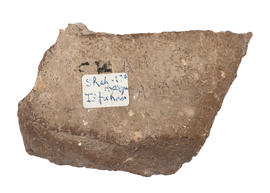Key Information
Reference code
NMC/0916C
Title
Ceramic tile fragment
Date(s)
- 19th century (Creation)
Level of description
Item
Extent
One item
Content and Structure
Scope and content
Polychrome (blue, green, yellow, white) glazed ceramic tile fragment with hand-painted floral and plant designs. 'Shah Isfahan' handwritten on verso. Label on verso - 'Shah - 17th mosque Isfahan.' The Shah Mosque (Persian), also known as Imam Mosque (Persian), is a mosque in Isfahan, Iran. It is regarded as one of the masterpieces of Irania/Persian architecture and an example of Islamic era architecture of Iran. It employed the haft rangi (seven-colour) style of tile mosaic.
Appraisal, destruction and scheduling
Accruals
System of arrangement
General Information
Name of creator
Biographical history
Archival history
Custodial history
Gifted to The Glasgow School of Art by Francis Newbery (see GSA minute book, 21/12/1921).
Physical Description and Conditions of Use
Conditions governing access
Conditions governing reproduction
Language of material
Script of material
Language and script notes
Physical Description
Polychrome glazed ceramic fragment.
Dimensions: 76 x 105 x 10 mm



